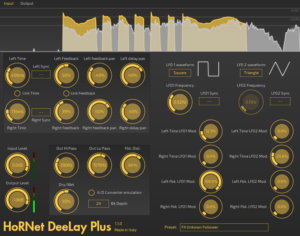DeeLay Plus
“HoRNet DeeLay Plus is an advanced digital delay that can be used to create space, moving sounds and also weird effects.
The core of the plugin are two separate delay units (called for convenience left and right) that can be routed to the left or the right channel independently, also the feedback of each unit can be cross-fed to the other one.
The standard delay controls like feedback and delay time are provided and can be linked together for quicker use, you can also sync the delay time to the host tempo.
DeeLay Plus gives you instant visual feedback thanks to the top waveform display that shows the input and output levels, those levels are also shown in the handy small peak meters next to the input and output knob so that you always have a meter close to your eyes when it matters.
HoRNet DeeLay Plus gives you many modulation and sound manipulation options, the feedback path can be filtered with a 6dB/oct low pass filter and a 6dB/oct high pass filter, followed by a distortion unit that goes from “clean” to “completely crushed” sound. Setting the feedback to 100% sends each delay unit int a “continuous loop” mode where the output sound never stops even if the input goes silent, entering this mode gives you weird and noisy sounds or looping hypnotic ones.
To make things more interesting we gave DeeLay Plus two LFO (Low Frequency Oscillators) that go from 0.1Hz to 10Hz. Each of the LFO provides four different waveform (sine, triangle, sawtooth and square) and each of the LFO can be routed simultaneously both to time and feedback level of each of the delay lines, it sounds complicated but in the end it means that you can modulate both time (creating pitch variations) and feedback (creating time variation) for each of the delay modules. Two LFOs means that complex waveform can be made as a modulation source and this in turn makes your moving sound more interesting.
DeeLay Plus also has a character of its own thanks to the Analog to Digital converter emulation that can be set to emulate converters from 24 bit to 8 bit for cheap 80s sounds.”
